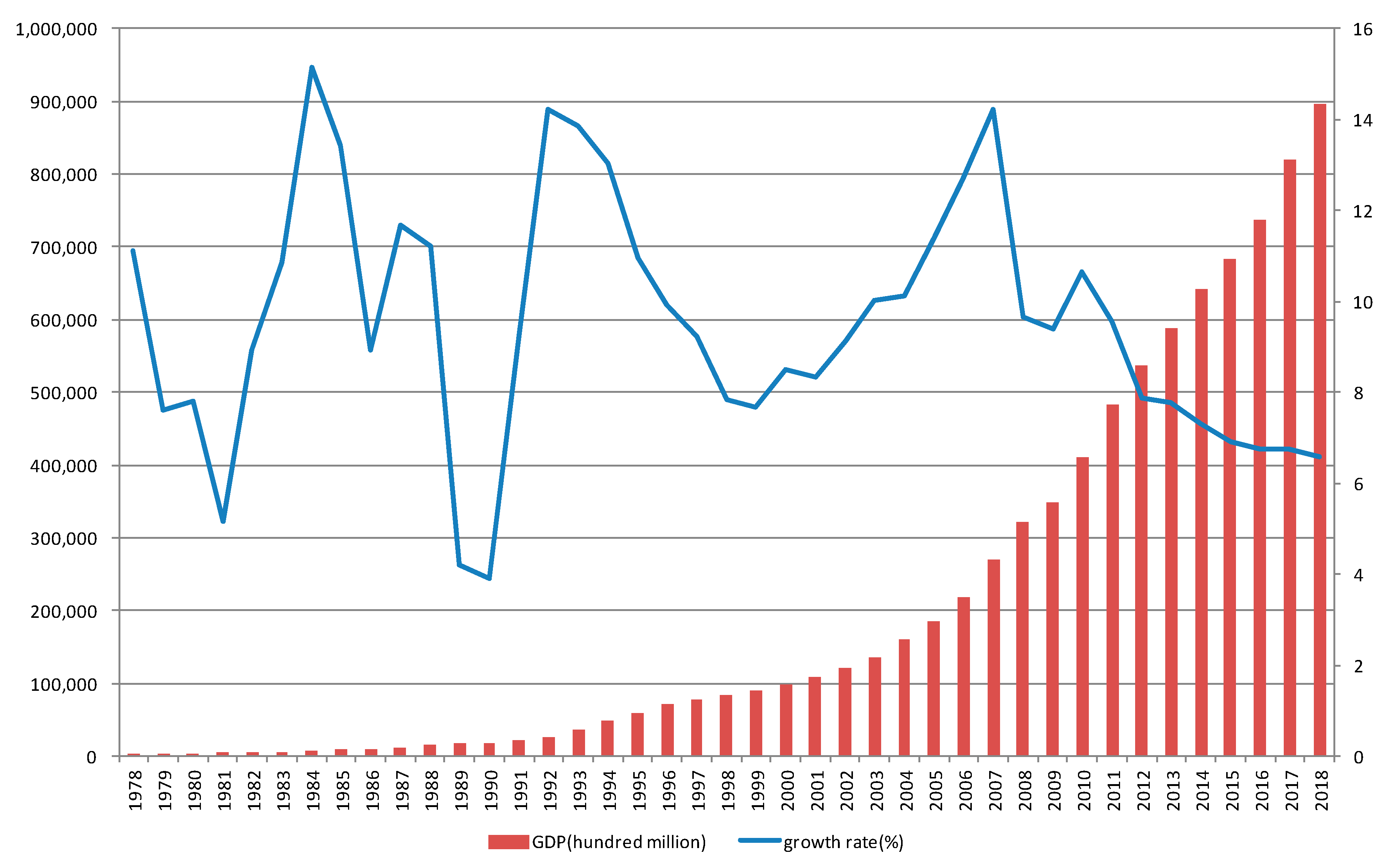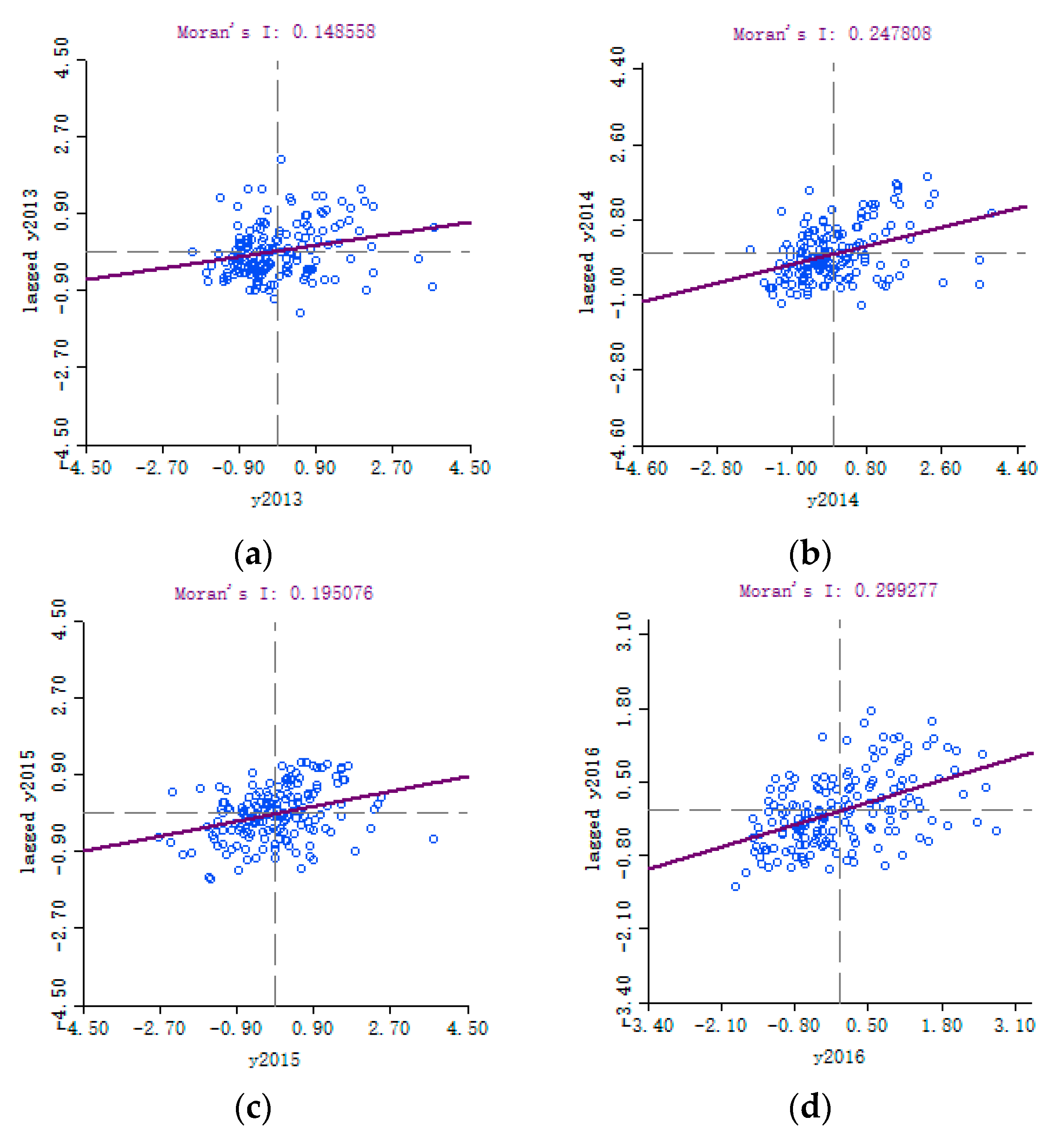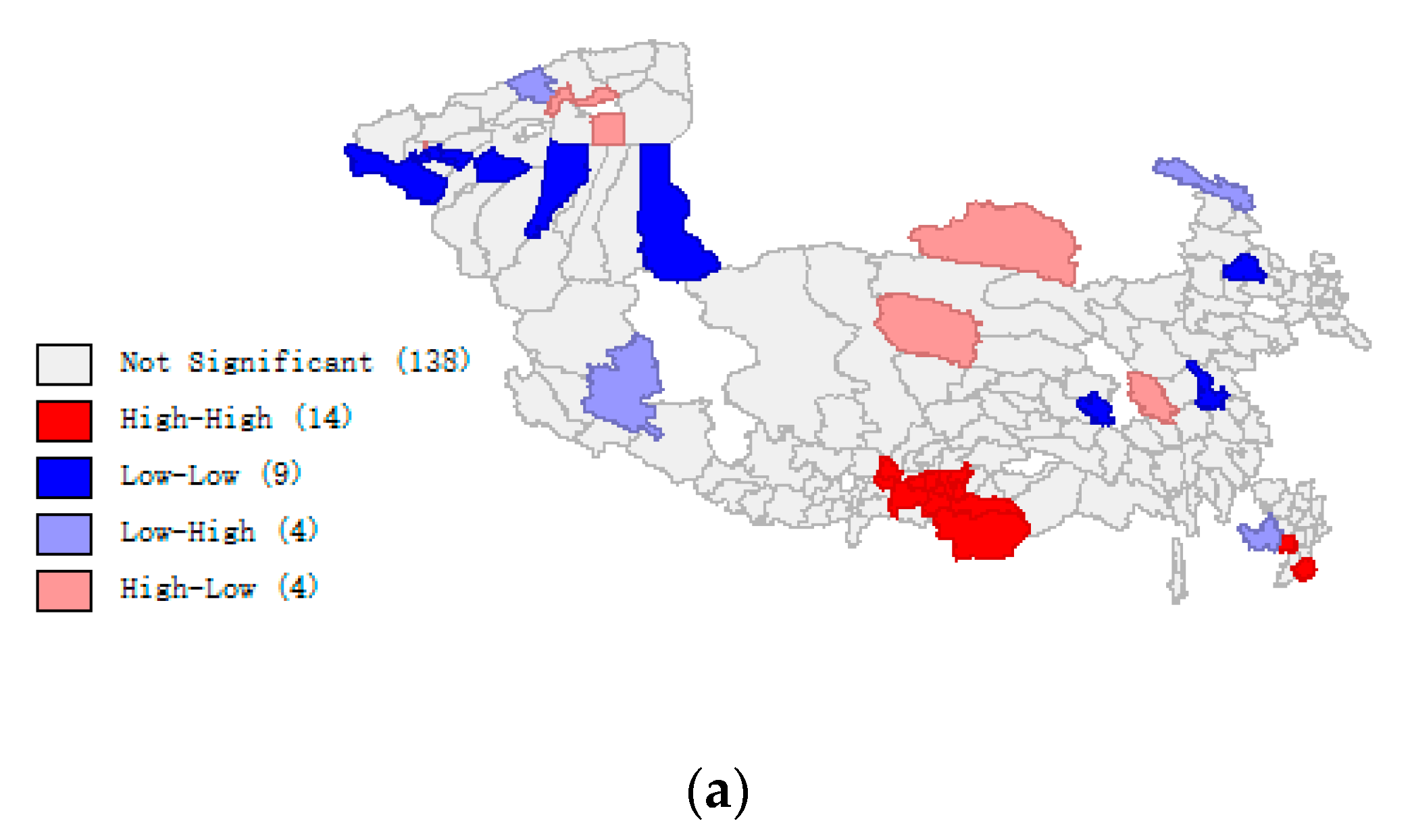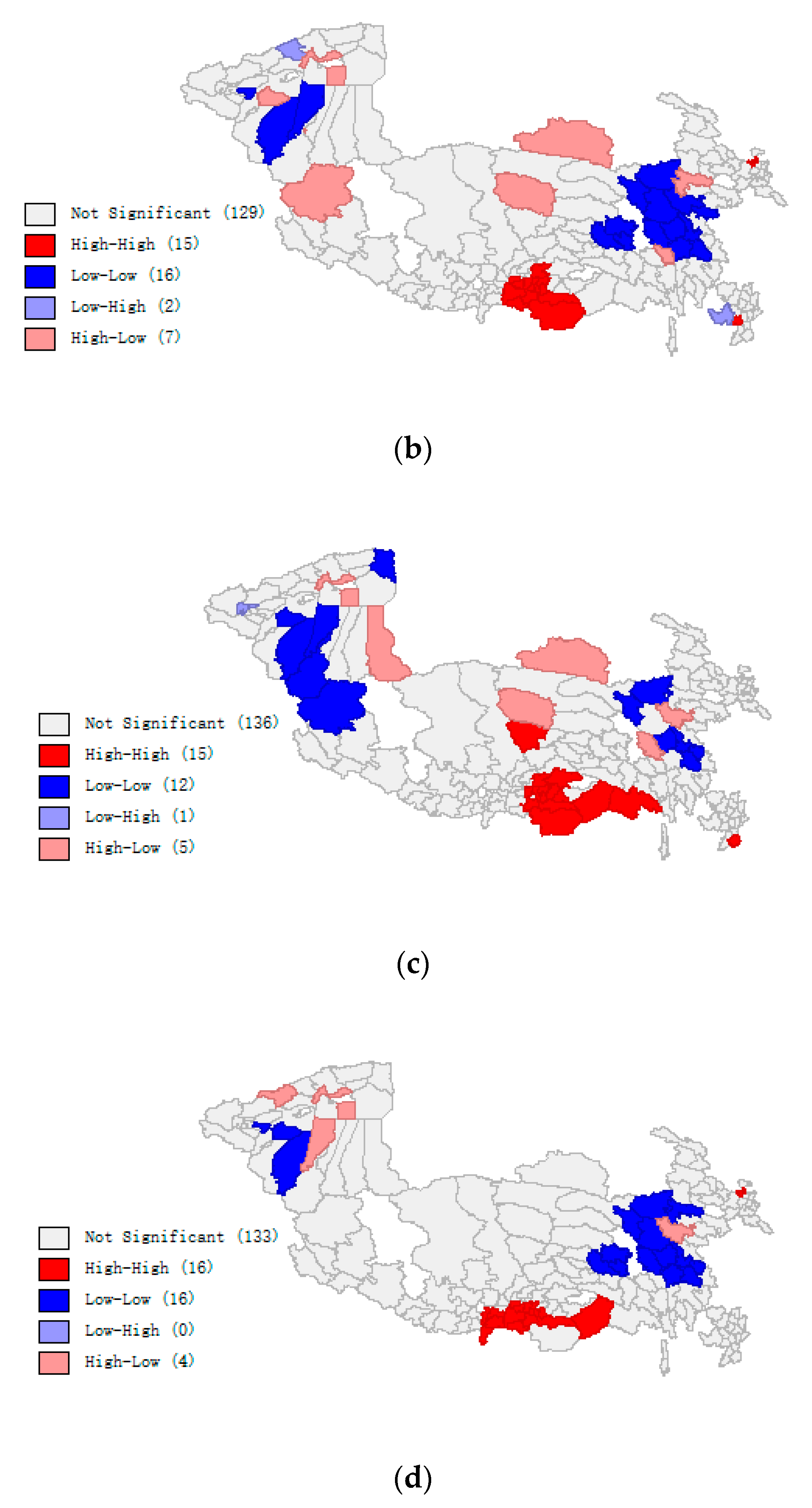The Temporal and Spatial Differentiation Characteristics of Three Industry Convergence Development in Deeply Impoverished Areas in China
Abstract
1. Introduction
2. Index System and Research Method
2.1. Index System Construction and Data Sources
2.2. Research Method
2.2.1. Entropy Method
2.2.2. Spatial Auto-Correlation Analysis
3. Results and Discussion
3.1. Comprehensive Evaluation and Analysis of the Integrated Development of Three Industries in Deeply Impoverished Areas
3.2. Overall Spatial Statistical Analysis of the Industry Integrated Development Level in the Deeply Impoverished Areas
3.3. Regional Spatial Statistical Analysis on the Industry Integrated Development Level
4. Conclusions and Recommendation
Author Contributions
Funding
Conflicts of Interest
References
- Rachwał, T. Industrial restructuring in Poland and other European Union states in the era of economic globalization. Procedia Soc. Behav. Sci. 2011, 19, 1–10. [Google Scholar] [CrossRef]
- Guo, J.H.; Guo, S.F. Construction and evaluation of the evaluation index system of cultural industry convergence innovation ability. Stat. Decis. 2019, 12, 62–65. [Google Scholar]
- Nathan, R. Technological Change in the Machine Tool Industry, 1840–1910. J. Econ. Hist. 1963, 23, 414–443. [Google Scholar]
- Hacklin, F.; Raurich, V.; Marxt, C. Implications of Technological Convergence on Innovation Trajectories: The Case of ICT industry. Int. J. Innov. Technol. Manag. 2005, 3, 313–330. [Google Scholar] [CrossRef]
- Stefanie, B.; Jens, L. Industry Convergence and Its Implications for the Front End of Innovation: A Problem of Absorptive Capacity. Creat. Innov. Manag. 2007, 16, 165–175. [Google Scholar]
- Greenstein, S.; Khanna, T. What does industry converge mean? In Competing in the Age of Digital Convergence; Yoffie, D.B., Ed.; Harvard Business School Press: Boston, MA, USA, 1997; pp. 201–226. [Google Scholar]
- Stieglitz, N. Digital dynamics and types of industry convergence: The evolution of the handheld computer market. In The Industrial Dynamics of the New Digital Economy; Edward Elgar Publishing: Cheltenham, UK, 2003; pp. 179–208. [Google Scholar]
- Chen, X. Industry Convergence and the Transformation of the Mobile Telecommunications System of Innovation. In Proceedings of the FITME ‘09, Second International Conference on Future Information Technology and Management Engineering, Sanya, China, 13–14 December 2009. [Google Scholar]
- De, B.P.; Peilz, M. Innovation, convergence and the role of regulation in the Netherlands and beyond. Telecommun. Policy 2008, 32, 744–754. [Google Scholar]
- Schmenner, R.W. Manufacturing, service, and their integrationaome. Int. J. Oper. Prod. Manag. Hist. Theory 2009, 29, 431–443. [Google Scholar] [CrossRef]
- Liu, S.W. Research on the Integration Development of Shiyan’s Cultural Industry and Tourism Industry Under the Background of Industrial Convergence. Int. Sci. Cult. Acad. Contacts 2018, 71, 638–644. [Google Scholar]
- Hu, Y.B. Integration Development Analysis of Cross-border Electric Merchants and Logistics Industry Chain in the Background of Industrial Convergence. In Proceedings of the 2017 International Conference on Innovations in Economic Management and Social Science (IEMSS 2017), Hangzhou, China, 15–16 April 2017. [Google Scholar]
- Hacklin, F.; Klang, D.; Baschera, P. Managing the Convergence of Industries: Archetypes for Successful Business Models. In Media and Convergence Management; Springer: Berlin/Heidelberg, Germany, 2013; pp. 25–36. [Google Scholar]
- Hacklin, F.; Marxt, C.; Fahrni, F. An Evolutionary Perspective on Convergence: Inducing a Stage Model of Inter-Industry Innovation. Int. J. Technol. Manag. 2010, 49, 220–249. [Google Scholar] [CrossRef]
- Richards, G. Cultural Tourism in Europe; Cab International: Wallingford, Oxfordshire, UK, 1996. [Google Scholar]
- Gao, Z.; Lu, Z.G. An empirical study on the insutry convergence level of equipment manufacutring industry and high-tech service industry based on system coupling theory. J. Syst. Sci. 2019, 27, 63–68. [Google Scholar]
- Chuanlei, W. Research on the Fusion of Informatization and Industrialization. Inf. Stud. Theory Appl. 2009, 32, 32–37. [Google Scholar]
- Kang, X.; Li, L.; Aiting, T. Integration of Informatization and Industrialization, Technical Efficiency and Convergency. Manag. Rev. 2009, 10, 50–60. [Google Scholar]
- Chandrashekar, A.; Schary, P.B. Toward the virtual supply chain: The convergence of IT and organization. Int. J. Logist. Manag. 1999, 10, 27–40. [Google Scholar] [CrossRef]
- Zhang, Y.L.; Cui, Q. The integration evaluation between industrialization and informatization in China. Sci. Res. Manag. 2013, 34, 43–49. [Google Scholar]
- Spring, M.; Araujo, L. Service, services and products: Rethinking operations strategy. Int. J. Oper. Prod. Manag. 2009, 5, 444–467. [Google Scholar] [CrossRef]
- Wang, F.; Pan, M.M. Industrial convergence, performance improvement and manufacturing industry growth: An empirical study based on panel data during 1998 to 2011. Stud. Sci. Sci. 2015, 33, 530–538. [Google Scholar]
- Li, H.; Ding, X. Analysis on the development of equipment manufacturing and producer services in China. Stat. Decis. 2019, 35, 120–124. [Google Scholar]
- Qi, L.Q.; Zhang, Q.N. Study on the network convergence influence factors of China’s equipment manufacturing industry and producer service. Sci. Technol. Prog. Countermeas. 2018, 35, 64–71. [Google Scholar]
- Min, L.; Shengzhong, Z.; Qunqi, W. The Game Analysis on the Main Factors of Logistics Industry Convergence. Econ. Manag. 2010, 5, 23–27. [Google Scholar]
- Tomilina, E.P.; Glotova, I.I.; Kuzmenko, I.P. Development of integration processes in the traditional sectors of agriculture. Middle East. J. Sci. Res. 2013, 13, 178–182. [Google Scholar]
- Uglitskikh, O.N.; Klishina, J.E. Modeling interregional inter-branch relations as an element of interaction between the branches of the agroindustrial complex. Middle East. J. Sci. Res. 2013, 13, 183–190. [Google Scholar]
- Dan, H.Y.; Xu, W.M. The study on motives and effects of tourism industry and culture industry merge: In the case of Sichuan province. Ecol. Econ. 2015, 31, 110–113. [Google Scholar]
- Gerasimov, A.N.; Gromov, Y.I.; Levchenko, S.A.; Grigorieva, O.P.; Oboturova, N.P. Features of the spatial socio-economic systems development in the North Caucasus Federal District. World Appl. Sci. J. 2014, 29, 699–705. [Google Scholar]
- Lu, H.; Zhang, Y.R. An empirical analysis of the driving forces for the integrated development of tourism and cultural and creative industries. Econ. Bus. Res. 2015, 13, 124–126. [Google Scholar]
- Wang, C.D. Regional industry convergence and the improvement of industrial R&D efficiency–empirical study based on SFA and 30 provincial areas of China. China Soft Sci. 2017, 9, 94–103. [Google Scholar]
- Xiao, J.Y.; Zheng, D.M. Modularity and industrial convergence: Coupling, mechanism, and effects. Sci. Technol. Manag. Res. 2012, 32, 13–15. [Google Scholar]
- Färe, R.; Grosskopf, S.; Margaritis, D. Productivity growth and convergence in the European Union. J. Product. Anal. 2006, 25, 111–141. [Google Scholar] [CrossRef]
- Gollop, F.M.; Monahan, J.L. A generalized index of diversification: Trends in US manufacturing. Rev. Econ. Stat. 1991, 73, 318–330. [Google Scholar] [CrossRef]
- Rachwał, T. Structural changes in Polish industry after 1989. Geogr. Pol. 2015, 88, 575–605. [Google Scholar] [CrossRef]
- Dominiak, J.; Rachwał, T. Chief development tendencies, structural changes and innovativeness of the industrial and service sectors in Poland. Quaest. Geogr. 2016, 35, 49–69. [Google Scholar] [CrossRef]
- Rachwał, T. Research Issues of Structural Changes in Polish Industry in Geography of Industry. Stud. Ind. Geogr. Comm. Pol. Geogr. Soc. 2018, 32, 86–109. [Google Scholar] [CrossRef]
- Kilar, W.; Rachwał, T. Changing Role of Industry in the Economy in the V4 Countries—A Regional Approach, ‘Club of Economics in Miskolc’. Theory Methodol. Pract. 2014, 10, 45–54. [Google Scholar]
- Gierańczyk, W.; Rachwał, T. Structural changes in the industry of Poland against the background of eastern European Union states. Quaest. Geogr. 2012, 31, 83–93. [Google Scholar]
- Fisher, A.G. Clash of Progress and Security; Macmillan and Co. Limited: London, UK, 1935. [Google Scholar]
- Clark, C. The Conditions of Economic Progress; McMillan: London, UK, 1940. [Google Scholar]
- Kuznets, S. Modern economic growth: Findings and reflections. Am. Econ. Rev. 1973, 63, 247–258. [Google Scholar]
- Porat, M.U. The Information Economy: Definition and Measurement; U.S. Government Printing Office: Washington, DC, USA, 1977.
- Provisions on Division of Three Industries. In Gazette of the State Council of the People’s Republic of China; 2003. Available online: http://www.stats.gov.cn/tjsj/tjbz/201804/t20180402_1591379.html (accessed on 16 January 2020).
- Zhong, S.Y.; Li, Q.Y.; Xu, F. Spatial inequality and distributional dynamics of the development level of agricultural modernization in China. China Popul. Resour. Environ. 2016, 26, 145–152. [Google Scholar]
- Zhang, Y.; Wang, X.J. Research on establishing index system and evaluating of agricultural modernization in Hubei province. Math. Pract. Theory 2016, 46, 154–159. [Google Scholar]
- Jiang, H.M.; Wang, Z.H. Empirical analysis on the relationship among industrialization, urbanization, and agricultural moderization in Jilin Province. Sci. Geogr. Sin. 2012, 32, 591–595. [Google Scholar]
- Zhong, J.J.; Wang, J. Correlation degree between China’s logistics industry and three industries: From perspective of industry convergence. Technol. Econ. 2013, 32, 39–44. [Google Scholar]
- Wu, Y.M. Newly assessment of synthetical development levels of service industry of 31 provincial regions of China. China Soft Sci. 2000, 10, 53–57. [Google Scholar]
- Jiang, H.; Zhang, K.J.; Zhang, H.Y.; Liu, Z.Y. Spatial-temporal difference and influence of China’s three industrial convergence development. Econ. Geogr. 2017, 37, 105–113. [Google Scholar]
- Levernier, W.; Partridge, M.D.; Rickman, D.S. The causes of regional variations in US poverty: A cross-county analysis. J. Reg. Sci. 2000, 40, 473–497. [Google Scholar] [CrossRef]
- Rupasingha, A.; Goetz, S.J. The Causes of Enduring Poverty: An Expanded Spatial Analysis of the Structural Determinants of Poverty in the US (No. 22); Northeast Regional Center for Rural Development: State College, PA, USA, 2003. [Google Scholar]
- Mallick, R.; Carayannis, E.G. Regional economic convergence in Mexico: An analysis by industry. Growth Chang. 1994, 25, 325–334. [Google Scholar] [CrossRef]
- Coulombe, S.; Lee, F.C. Convergence across Canadian provinces, 1961 to 1991. Can. J. Econ. 1995, 28, 886–898. [Google Scholar] [CrossRef]
- Guo, S.F.; Guo, J.H. Theoretical Analysis and Empirical Study of the Integration Innovation Driving Force in Cultural Industry. J. Nanjing Univ. Technol. 2019, 18, 89–98. [Google Scholar]
- Zang, M.D.; Lou, Z.M.; Kong, J.J. Spatial-temporal differentiation of interprovincial water well-being performance in China. Resour. Environ. Yangtze Basin 2019, 28, 805–816. [Google Scholar]
- Brooks, M.M. The Advantages of Comparative LISA Techniques in Spatial Inequality Research: Evidence from Poverty Change in the United States. Spat. Demogr. 2019, 7, 167–193. [Google Scholar] [CrossRef]
- Fowler, C.S.; Kleit, R.G. The effects of industrial clusters on the poverty rate. Econ. Geogr. 2014, 90, 129–154. [Google Scholar] [CrossRef]
- Sjafii, A.; Mega, P.V.N. Investigating Economic Growth Impact on Poverty Reduction in East Java: Does Spatial Matter? Majalah Ekonomi 2011, 21, 1. [Google Scholar]
- Rupasingha, A.; Goetz, S.J. Social and political forces as determinants of poverty: A spatial analysis. J. Socio-Econ. 2007, 36, 650–671. [Google Scholar] [CrossRef]
- Gundersen, C. Are the effects of the macroeconomy and social policies on poverty different in nonmetro areas in the United States? Rural Sociol. 2006, 71, 545–572. [Google Scholar] [CrossRef]
- Tacoli, C.; McGranahan, G.; Satterthwaite, D. Urbanization, poverty and inequity: Is rural–urban migration a poverty problem, or part of the solution? In The New Global Frontier; Routledge: Abingdon-on-Thames, UK, 2012; pp. 51–68. [Google Scholar]
- Nijkamp, P. Regional development as self-organized converging growth. In Spatial Disparities and Development Policy; The World Bank: Washington, DC, USA, 2009; pp. 265–282. [Google Scholar]
- Storper, M. The limits to globalization: Technology districts and international trade. Econ. Geogr. 1992, 68, 60–93. [Google Scholar] [CrossRef]
- Howells, J. Regional systems of innovation. In Innovation Policy in a Global Economy; Cambridge University Press: Cambridge, UK, 1999; pp. 67–93. [Google Scholar]
- Wang, M.Q.; Wang, N. Analysis of Anti-poverty Path Selecting in Western Ethnic PovertyBelt—Based on the Perspective of Space Poverty Theory. Guizhou Ethn. Stud. 2011, 32, 141–145. [Google Scholar]
- HAO, X.Z.; LI, Y.M. Reasons analyses and solutions discussions of poverty in Nujiang prefecture. J. Yunnan Univ. Nat. Sci. Ed. 2007, 29, 166–172. [Google Scholar]
- Goodland, R.; Daly, H. Why Northern income growth is not the solution to Southern poverty. Ecol. Econ. 1993, 8, 85–101. [Google Scholar] [CrossRef]
- Partridge, M.D.; Rickman, D.S. Distance from urban agglomeration economies and rural poverty. J. Reg. Sci. 2008, 48, 285–310. [Google Scholar] [CrossRef]
- Crandall, M.S.; Weber, B.A. Local social and economic conditions, spatial concentrations of poverty, and poverty dynamics. Am. J. Agric. Econ. 2004, 86, 1276–1281. [Google Scholar] [CrossRef]
- Fontenot, K.; Singelmann, J.; Slack, T.; Siordia, C.; Poston, D.L., Jr.; Saenz, R. Understanding falling poverty in the poorest places: An examination of the experience of the Texas Borderland and Lower Mississippi Delta, 1990–2000. J. Poverty 2010, 14, 216–236. [Google Scholar] [CrossRef]




| Methods | Characteristics |
|---|---|
| fusion coefficient method | By examining the correlation coefficient of patent shares among selected industries and judging the degree of industrial integration through the change of correlation coefficient matrix, it is not suitable for the research at the macro level |
| DEA | The efficiency of industrial integration is measured by the input-output index of each industry |
| Herfindahl index method | The degree of industrial integration can be calculated by the sum of the square proportions of the revenue or assets of each competitive entity in an industry and the total of the industry, but the problem of multicollinearity cannot be solved |
| input–output method | The input coefficient reflects the direct consumption of other products in the production process of an industry, which is a one-way connection. Its accuracy is largely affected by the availability of data |
| comprehensive index method | The analytic hierarchy process (AHP) is used to calculate the weights and take the product with the index data |
| entropy and spatial autocorrelation analysis method | The entropy method is decomposable and can solve the problem of multicollinearity which cannot be solved by the Herfindahl index method. The spatial autocorrelation method can be used to study the agglomeration relation and spatial distribution characteristics of three industries in deep poverty areas based on the entropy measure |
| The First Level Index | Weight | The Second Level Index | Calculating Method | Weight | Index Attribute |
|---|---|---|---|---|---|
| Agriculture | 1/3 | Per capita income of rural residents | Per capita income of rural residents | 0.217 | Positive |
| Agricultural mechanization level | Total power of agricultural mechanization/agricultural arable land (kw/hm2) | 0.157 | Positive | ||
| Per unit area yield of grain | Total grain output/area sown to grain (kg/hm2) | 0.172 | Positive | ||
| Effective irrigation rate for agriculture | Available irrigated area/agricultural arable area (%) | 0.176 | Positive | ||
| Rural Engel coefficient | Food expenditure/consumer expenditure of rural residents (%) | 0.271 | Negative | ||
| Industry | 1/3 | Rate of industrialization | Industrial added value/GDP (%) | 0.149 | Positive |
| Profit margin of industrial output | Total industrial profits/output value | 0.174 | Positive | ||
| Industrial productivity | Industrial added value/employees (ten thousand RMB/person) | 0.240 | Positive | ||
| Contribution rate of total assets | (total profit and tax + interest expense)/total average assets (%) | 0.187 | Positive | ||
| Ratio of foreign investment | Investment by foreign enterprises/Total industrial output value above scale | 0.250 | Positive | ||
| service industry | 1/3 | GDP per capita | GDP/total population (RMB) | 0.173 | Positive |
| Output level of service industry | Growth rate of output value of service industry (%) | 0.194 | Positive | ||
| The proportion of output value of service industry | The added value of the service industry/GDP in the area (%) | 0.190 | Positive | ||
| Total value of service industry | Total value of service industry (One hundred million RMB) | 0.233 | Positive | ||
| The proportion of service industry investment | Fixed assets investment in the service industry/total fixed assets investment (%) | 0.210 | Positive |
| Classification | U ≥ 0.5 | 0.4 ≤ U < 0.5 | 0.3 ≤ U < 0.4 | 0.2 ≤ U < 0.3 | 0.1 ≤ U < 0.2 | |
|---|---|---|---|---|---|---|
| Year | ||||||
| 2013 | 1 (1.18%) | 4 (2.37%) | 42 (25.44%) | 118 (68.64%) | 4 (2.37%) | |
| 2014 | 0 (0) | 8 (5.33%) | 48 (27.22%) | 112 (66.86%) | 1 (0.59%) | |
| 2015 | 0 (0) | 4 (2.96%) | 108 (63.31%) | 57 (34.32%) | 0 (0) | |
| 2016 | 0 (0) | 2 (1.78%) | 59 (34.32%) | 108 (63.91%) | 0 (0) | |
| Index | 2013 | 2014 | 2015 | 2016 |
|---|---|---|---|---|
| Moran’s I | 0.1486 | 0.2478 | 0.1951 | 0.2993 |
| Z | 3.0487 | 4.5703 | 3.7965 | 5.4555 |
| P | 0.0030 | 0.0010 | 0.0010 | 0.0010 |
| Year | HH | HL | LL | LH |
|---|---|---|---|---|
| 2013 | Cuona County, Longzi County, Cuomei County, Qusong County, Sangri County, Naidong County, Qiongjie County, Dechang County, Huidong County, Zhanang County, Langkazi County, Gongga County, Renbu County, Nimu County. | Jiangda County, Geermu County, Aersu County | Ganzi County, Guinan County, Leiwuqi County, Aketao County, Shule County, Yuepuhu County, Maigaiti County, Moyu County, Minfeng County | Geji County, Qilian County, Wushi County, Yanyuan County |
| 2014 | Cuona County, Longzi County, Qusong County, Sangri County, Mozhugognka County, Naidong County, Qiongjie County, Cuomei County, Luozha County, Zhanang County, Gongga County, Qushui County, Langkazi County, Dechang County, Linxia County | Akesu County, Maigaiti County, Hetian County, Ritu County, Gongjue County, Maqin County | Yuepuhu County, Pishan County, Moyu County, Nangqian County, Leiwuqi County, Dingqing County, Chendu County, Duoma County, Shiqu County, Dari County, Banma County, Jiangda County, Dege County, Ganzi County, Baiyu County, Xinlong County | Wushi County, Yanyuan County |
| 2015 | Cuona County, Longzi County, Motuo County, Chayu County, Lang County, Jiacha County, Gongbujiangda County, Mozhugongka County, Sangri County, Qusong County, Naidong County, Zhanang County, Cuomei County, Anduo County, Huidong County | Dari County, Jiangda County, Geermu County, Minfeng County, Akesu County | Chenduo County, Duoma County, Dege County, Ganzi County, Luhuo County, Xinlong County, Kuche County, Moyu County, Maigaiti County, Pishan County, Hetian County, Ritu County | Shufu County |
| 2016 | Linxia County, Motuo County, Longzi County, Qusong County, Naidong County, Qiongjie, Zhanang County, Gongge County, Qushui County, Langkazi County, Luozha County, Cuomei County, Jiangzi County, Kangma County, Bailang County, Yadong County | Dari County, Akesu County, Moyu County, Aheqi County | Maigaiti County, Yuepuhu County, Yecheng County, Nangqian County, Leiwuqi County, Dingqing County, Maduo County, Maqin County, Chenduo County, Shiqu County, Jiangda County, Dege County, Ganzi County, Luhuo County, Xinlong County, Baiyu County |
© 2020 by the authors. Licensee MDPI, Basel, Switzerland. This article is an open access article distributed under the terms and conditions of the Creative Commons Attribution (CC BY) license (http://creativecommons.org/licenses/by/4.0/).
Share and Cite
Zhang, N.; Zhang, X.; Li, P. The Temporal and Spatial Differentiation Characteristics of Three Industry Convergence Development in Deeply Impoverished Areas in China. Sustainability 2020, 12, 831. https://doi.org/10.3390/su12030831
Zhang N, Zhang X, Li P. The Temporal and Spatial Differentiation Characteristics of Three Industry Convergence Development in Deeply Impoverished Areas in China. Sustainability. 2020; 12(3):831. https://doi.org/10.3390/su12030831
Chicago/Turabian StyleZhang, Na, Xiangxiang Zhang, and Peng Li. 2020. "The Temporal and Spatial Differentiation Characteristics of Three Industry Convergence Development in Deeply Impoverished Areas in China" Sustainability 12, no. 3: 831. https://doi.org/10.3390/su12030831
APA StyleZhang, N., Zhang, X., & Li, P. (2020). The Temporal and Spatial Differentiation Characteristics of Three Industry Convergence Development in Deeply Impoverished Areas in China. Sustainability, 12(3), 831. https://doi.org/10.3390/su12030831





